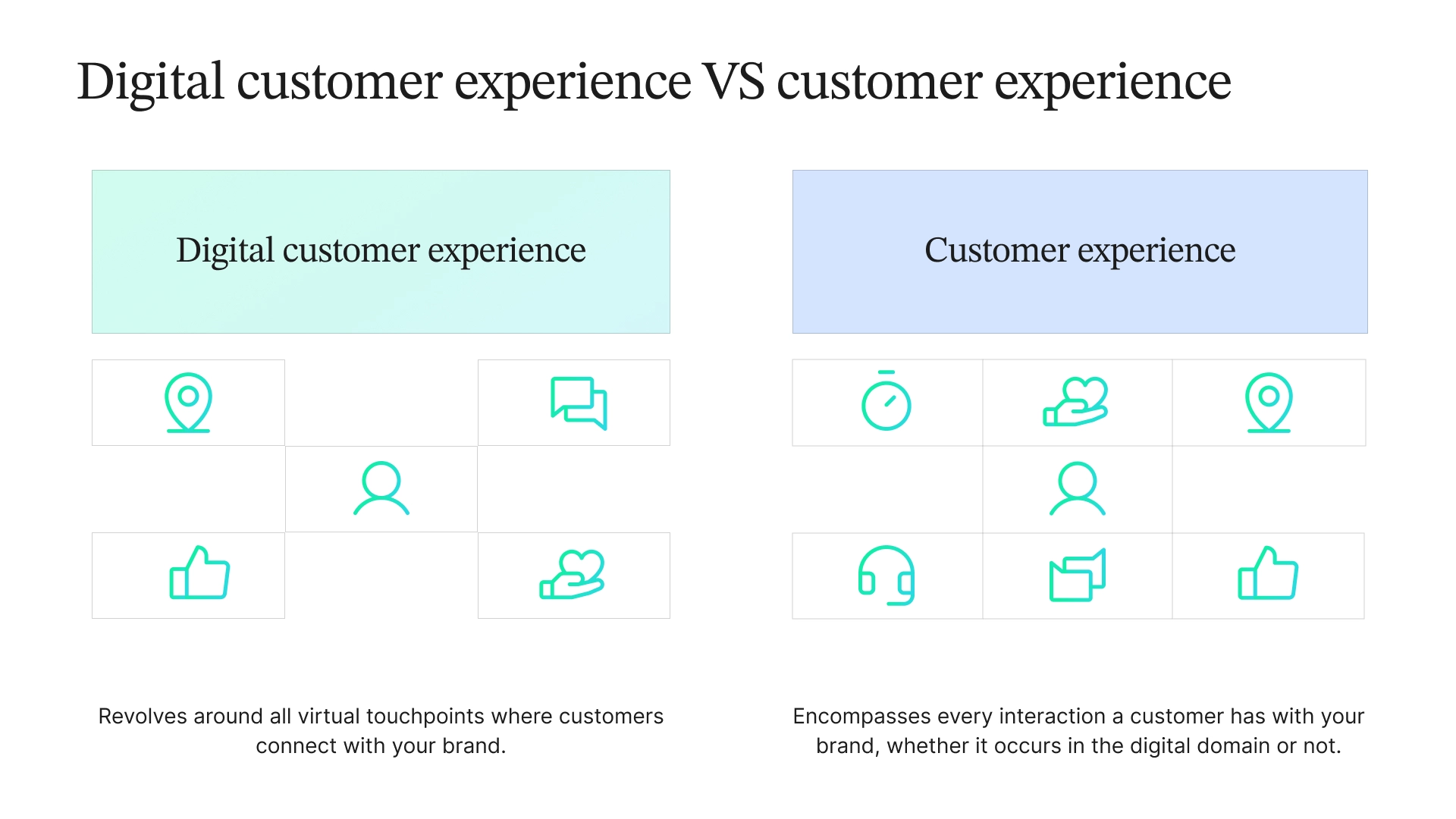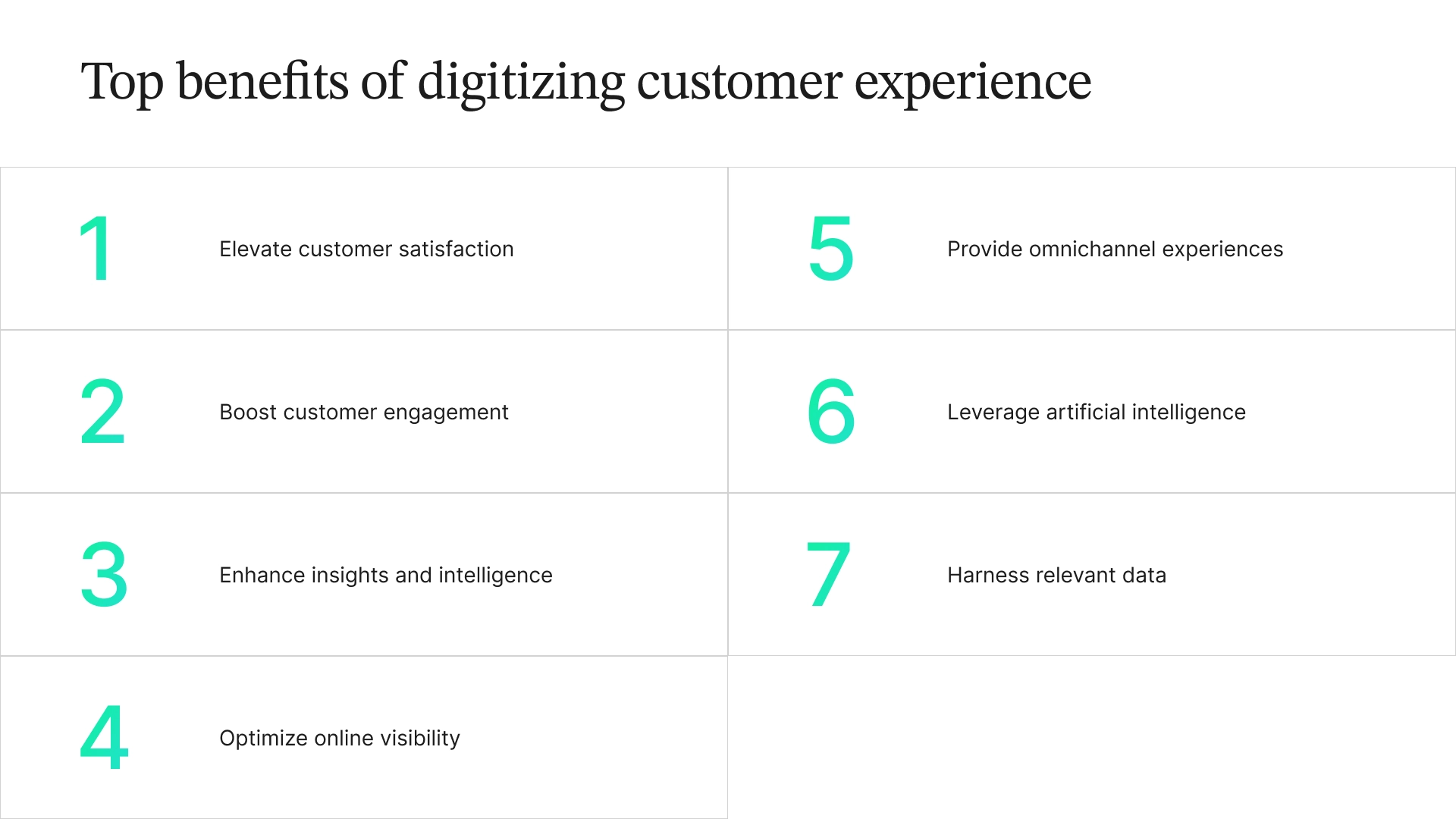In the ever-evolving landscape of customer service, the true competitive advantage lies in embracing the synergy between cutting-edge technologies and the irreplaceable human touch. Businesses that successfully navigate this balance not only drive digital transformation but also cultivate deeper, more meaningful connections with their customers. This is the impact of digitizing customer experience.
Embracing artificial intelligence (AI) solutions can be a powerful catalyst for digital transformation and generating positive customer experiences. However, as businesses integrate these advanced CX tools, it is crucial to maintain a delicate balance by preserving the personalized tone, authentic problem-solving interest, and service warmth that clients crave.
Zendesk’s CX Trends 2024 report sheds light on the effects of digitizing customer experience. According to the research, 67% of CX leaders believe bots can build a stronger emotional connection with customers in the immediate future. The same report states that 70% of consumers believe AI has become a modern part of their customer service interactions.
On the other hand, there are still many industries where human-based customer experience is almost mandatory. A recent MarketingCharts survey found that, when receiving advice from a nurse/doctor about a minor issue, 81% share of respondents would prefer a human interaction.
With over eight years of delivering world-class business process outsourcing (BPO) services, Helpware has established itself as a trusted partner in navigating the complexities of the digital customer experience landscape. Keep reading to learn more about the transformative power of digitizing CX, and how you can harness this methodology to foster a deeper relationship with your clients.
What is Customer Experience Digitization?
Customer experience digitalization refers to the comprehensive integration of digital technologies across all aspects of a business. This approach aims to radically transform operational processes and enhance the value propositions offered to customers.
Embracing customer experience digitization often challenges traditional norms that are well-rooted in the foundation of organizations. This means fostering a culture of experimentation and accepting failures as part of the growth journey. It often requires discarding outdated business practices in favor of emerging, innovative ones.
Digitalizing customer experience also entails the seamless integration of cutting-edge technologies throughout the entire customer journey. This could introduce previously unexplored communication channels, such as social media and web chat, into your organization’s daily automated activities for marketing, sales, and customer service.
The digital customer experience enables personalized customer engagement through various touchpoints, including websites that use cookies to collect data, mobile apps, social media platforms, or online portals owned by the company.
It encompasses the entire customer journey, from browsing products and making purchases to seeking support and providing feedback. This empowers businesses to align themselves with the evolving needs of tech-savvy customers who expect seamless, omnichannel interactions.
By digitizing customer experience data analytics provides a data-driven approach to understanding customer behavior and identifying patterns. Leveraging the precision of digital services allows companies to automate their processes, mitigate manual errors, and ensure consistent, high-quality experiences.
Digital Customer Experience vs. Customer Experience
Digital customer experience revolves around the virtual touchpoints where customers feel a real connection with your brand, such as navigating mobile applications, exploring websites, and engaging on social media platforms. It encompasses the entirety of the digital realm where customers interface with your products or services.
In contrast, customer experience, in its broadest sense, encompasses every interaction a customer has with your brand, whether they occur in the digital domain or through physical channels and touchpoints. It is the culmination of all the encounters, impressions, and experiences that shape a customer’s perception of your brand.
In today’s digital-based business development scenario, the lines between “digital customer experience” and “customer experience” are blurring, as the two concepts are becoming increasingly intertwined and interdependent.
By following the following structured approach, you can navigate your digitizing CX transformation journey with confidence, ensuring that your efforts are aligned with customer needs, leveraging existing solutions where appropriate, and maintaining the agility to adapt to changing circumstances while continually measuring and optimizing your progress:
Understand your customer
To craft an effective digital customer experience strategy, you should commence by collecting and analyzing quantitative and qualitative data. This crucial step will enable you to make well-informed business decisions, tailoring your products and services to better align with customer needs and preferences.
Prioritize the most demanding processes
Digitizing customer experience for any enterprise is a significant undertaking, but you need not tackle it all simultaneously. We recommend a phased approach, focusing your initial efforts on the processes that would benefit most from digitization.
Explore existing digital solutions
You need not reinvent the wheel or develop everything in-house. Numerous ready-made solutions and systems are available for you to implement within your enterprise. For instance, system integration testing plays a crucial role in ensuring that various digital tools and platforms work cohesively, helping businesses identify and resolve potential compatibility issues early. This is particularly evident in the retail sector, where digital tools are revolutionizing customer interactions and operational efficiency, accelerating your retail digital transformation journey.
Cultivate an adaptable mindset
Success in the modern business world hinges on agility and flexibility. These are essential not only for customer-focused digital transformation but also for internal initiatives like supply chain digitization, HR digital transformation, automated financial operations, etc. Be prepared to adapt and innovate as circumstances evolve or new opportunities arise.
Monitor and measure progress
Regularly track and measure the progress of each task to ensure your digital transformation efforts are moving in the desired direction. Leverage key performance indicators (KPIs) to quantify the success of your digital customer experience initiatives, enabling data-driven decision-making.

Top Advantages of Digitizing Customer Experience
For many companies all over the globe, embracing a comprehensive customer experience digitization strategy is rapidly becoming an imperative feature. At its core, a well-crafted digitization plan is crucial for delivering exceptional experiences that resonate with your target audience.
Innovative tools, such as analytical platforms, machine learning algorithms, and even generative AI, are revolutionizing customer experiences in multiple fashions. These cutting-edge solutions facilitate personalized and efficient interactions, empowering employees to accomplish tasks more quickly while nurturing proactive engagement through timely follow-ups and tailored messaging.
Moreover, digital tools equip businesses with the ability to track and learn from customer interactions seamlessly. By enabling the collection of valuable data, these solutions assist companies in strengthening brand loyalty and driving revenue growth.
By embracing a comprehensive customer experience digitization strategy, organizations can unlock a wealth of opportunities to connect with their audience, anticipate their evolving needs, and deliver personalized interactions.
Let’s take a closer look at some of the most relevant benefits of providing a high-end digital customer experience:
- Elevate customer satisfaction: According to a Forrester survey, customers are 2.4 times more likely to stick with a brand when their problems are solved quickly. A robust digital strategy ensures that you can connect with customers through their preferred channels, delivering personalized and tailored experiences that exceed their expectations.
- Boost customer engagement: Digital technologies empower companies to meet customer expectations consistently across multiple touchpoints. They enable automated marketing and sales communications, prompt responses to inquiries, and even facilitate self-service options, fostering a sense of seamless interaction and accessibility.
- Enhance insights and intelligence: With the power of digital tools, companies can gain invaluable insights into customer preferences, buyer behaviors, and market trends. This intelligence allows for the creation of more advanced and tailored customer experiences, driving increased sales and cultivating long-lasting brand loyalty.
- Optimize online visibility: Effectively communicating your website’s SEO strategy and performance through a well-structured pitch deck can be invaluable, demonstrating how your efforts align with business objectives and contribute to improved online visibility and understanding user behavior.
- Provide omnichannel experiences: Complementing multi-channel personalization is the ability to offer an omnichannel experience, allowing customers to communicate with a brand through their preferred channels, whether self-service or live chat.
- Leverage artificial intelligence: While artificial intelligence (AI) is often lauded for its potential to enhance efficiency, its impact on user experience should not be overlooked. AI solutions are becoming vital in improving digital touchpoints to enhance customer experience.
- Harness relevant data: Collecting qualitative feedback through surveys helps identify pain points, such as navigation issues or conversion obstacles. Open-ended questions and qualitative customer feedback provide a comprehensive understanding of the digital customer experience.

10 Steps to Digitize Customer Experience for Your Business
Embarking on the journey of digitizing customer experiences can seem like a daunting task. Trends in customer experience, communication, and buying behaviors are constantly evolving, necessitating businesses to continuously optimize and refine their digital strategies.
At Helpware, they are committed to empowering SMEs by providing comprehensive guidance on leveraging digital CX methodologies to foster more meaningful and engaging interactions with their customers. Our expertise spans the most critical aspects of this transformative approach, enabling our partners to stay ahead of the curve and thrive in an increasingly digital arena.
Whether you’re seeking to streamline operations, enhance customer engagement, or drive innovation within your service delivery model, the following strategic blueprint will illuminate the critical steps and considerations necessary to digitize customer experience in the best possible way:
Craft buyer personas to understand your customers
Truly innovative and personalized digital customer experiences stem from a deep understanding of your customers and target audience. Developing data-driven customer personas or user personas is the first step. These personas should provide a comprehensive overview of your customers’ pain points, demographics, buying patterns, and motivations.
Buyer personas will guide you in identifying critical touchpoints along the customer journey that may require updates or enhancements. Additionally, they’ll help you build a complete customer journey map, offering a visual representation of how personas navigate through digital experiences. Analyzing the experiences and services offered by competitors can also provide valuable insights for benchmarking and improving your CX strategy.
Build an omnichannel customer service strategy
An omnichannel environment goes beyond linking multiple channels like social media and web chat. It removes silos between these channels, enabling seamless data and information flow from one environment to the next.
To fully digitize the customer experience, it is possible to leverage an omnichannel Contact Center as a Service (CCaaS) platforms that integrate with other tools like CRM and ERP systems will make it easier to visualize and enhance every stage of the customer journey. It also ensures that your employees can connect with customers in a personalized and engaging manner.
Leverage evolving service channels
Live chat has emerged as one of the most influential and popular tools and strategies for customer service in today’s market. Both live and AI-driven chatbots empower companies to connect with consumers in new, more efficient ways. There are even generative AI solutions available to offer creative and personalized self-service experiences.
To digitize customer service, chat solutions enable customers to interact and solve problems quickly, facilitate proactive outreach, and boost engagement. Alongside chat, channels like SMS interactions, live video, and social media are becoming popular approaches to managing meaningful touchpoints with clients, while tools like digital business cards provide a quick and professional way to share contact information.
Integrate data when digitizing customer experience
Digitizing the customer experience isn’t just about adding new digital channels to your contact center environment. It also means leveraging next-level technology to enhance how you serve your customers. Tools that help companies capture customer experience analytics and insights offer a valuable way to optimize the customer journey.
With intelligent solutions, companies can rapidly capture information about customer preferences and pain points, using it to personalize every interaction. The right data and analytics can streamline processes like scheduling and aligning employees in a distributed contact center.
Train agents for the digital transformation
When updating your customer experience strategy, few things are more important than providing your agents with the necessary training. As new channels emerge in your contact center, your customer service and sales teams will need to acquire new skills.
Teaching team members how to correctly utilize intelligent assistants, analytical tools, and new channels is crucial for various reasons. Not only does it ensure rapid adoption of new digital media for customer service, but it also helps to maintain compliance.
Implement AI tools and strategies
Artificial Intelligence (AI) is quickly becoming an essential part of digitizing the customer experience. AI solutions empower companies to bring new self-service capabilities and experiences to consumers with generative chatbots and assistants. AI in call centers is a prime example of how these technologies can enhance efficiency and customer satisfaction.
However, it’s essential to implement these solutions with caution. Overuse of AI may result in unexpected exceptions and errors that only add friction instead of removing it. Iterative tasks, high-volume processes, data transfers, and language analysis are best suited to digitize customer service through AI implementations.
Balance experimentation with standardization
A standardized plan for digitizing the customer experience should make training agents, designing processes, and implementing the right technologies easier. However, an overly conservative focus on standardization could increase resistance to change.
Companies must strike a balance between ethical and compliant practices and experimentation to stay ahead of the competition. Leveraging and tracking the right information is an excellent way to find this balance. Ensure you know the compliance standards for various forms of customer communication in your industry.
Collect qualitative feedback
While quantitative data about call handling times, response rates, and other factors can aid in digitizing the customer experience, collecting qualitative data is equally crucial. The voice of the customer should form an essential component of your strategy for long-term growth.
Gathering in-depth feedback will help you determine which parts of your digital customer service strategy drive loyalty and retention. You’ll be able to collect suggestions from your audience on how to improve their journey and make more meaningful changes in the future.
Optimize data security
Customers expect companies to guard and respectfully use their personal details, financial information, and sensitive data. Any breach of security can have devastating consequences. Not only can it tarnish a company’s reputation, but it may also result in substantial financial losses and potential legal ramifications.
By implementing robust security measures and identity theft insurance, businesses can demonstrate their commitment to protecting customer data and fostering a trusted relationship with their customers. Prioritizing data security not only safeguards sensitive information but also cultivates customer loyalty and establishes a competitive advantage in the digital marketplace.
Consider every aspect of the customer journey
Finally, it’s worth remembering that the customer journey involves more than just sales and customer service. To truly invest in digitizing the customer experience, companies need to consider every aspect of their customer relationship.
This could mean implementing new automated marketing strategies, reaching out to customers, and following up with them across multiple channels. For example, businesses can automate LinkedIn outreach to connect with prospects and nurture relationships more efficiently. It could also mean crafting new strategies for onboarding customers and investing in customer success.
A holistic approach to digitizing the customer experience ensures companies can build powerful, long-term consumer relationships, minimizing churn.

Unlocking Digital CX Excellence with Helpware
By digitizing customer experience seamlessly into the customer journey, businesses can offer unparalleled convenience, management, and real-time support, fostering deeper connections with their customer base. This digital transformation not only enhances the overall customer experience but also unlocks new avenues for operational efficiency, data-driven insights, and tailored solutions.
Whether it’s optimizing your online presence, integrating cutting-edge technologies, helping your target audience to interact with your brand, or developing an omnichannel customer experience, Helpware’s comprehensive suite of services empowers SMEs to deliver real interactions that resonate with their target audience.
Working with Helpware means that companies from every industry and size gain a trusted ally in their pursuit of digital CX development and CX Consulting. Get in touch with us so we can help you navigate the process of digitization, nurture meaningful connections with your target audience, and unlock new avenues for growth and success. Upscale your CX results today.












